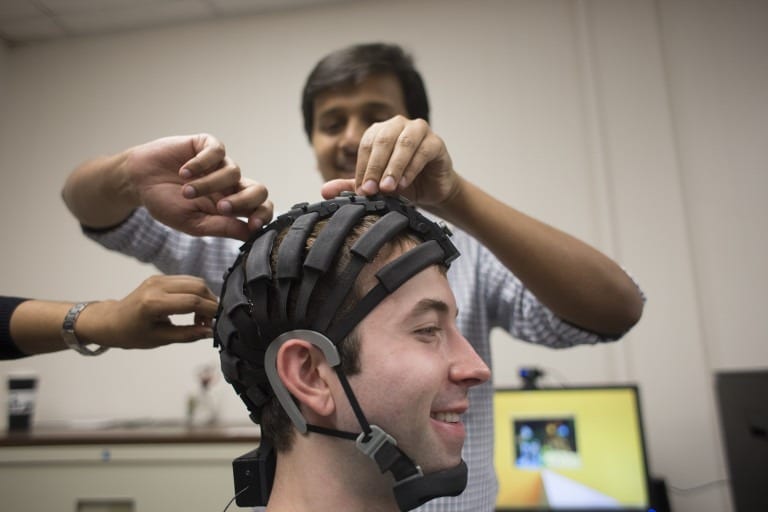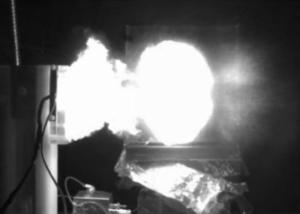
The work has potential in next-generation high-speed communication and biomedical imaging
Researchers at the University of Wisconsin-Milwaukee (UWM) have found a new mechanism to transmit light through optical fibers. Their discovery marks the first practical application of a Nobel-Prize-winning phenomenon that was proposed in 1958.
Assistant Professor Arash Mafi and doctoral student Salman Karbasi harnessed “Anderson localization” to create an optical fiber with a strong scattering mechanism that traps the beam of light as it traverses the fiber. The work was done in collaboration with Karl Koch, a scientist with Corning Inc.
Data transmission through conventional optical fibers – in which only one spatial channel of light traverses the fiber – is the backbone of the Internet. Such single-core fibers, however, are reaching the limits of their information-carrying capacity, says Mafi.
Propagation of multiple optical beams in a single strand of optical fiber is a sought-after solution to overcome this limitation. The collaboration’s novel discovery achieves this.
The work has potential in next-generation high-speed communication and biomedical imaging, but it also opens the door for more uses of “Anderson localization” in technology.
“Anderson localization” is named after physicist Philip W. Anderson, who first theoretically observed the curious containment of electrons in a highly disordered medium, an observation for which he shared the 1977 Nobel Prize in physics, but one that is still under investigation.
Mafi and Karbasi’s fiber design consists of two randomly distributed materials, which scatter the photons.
The fiber’s disordered interior causes a beam of light traveling through it to freeze laterally. The output light can follow any shift in the location of the entry point as it moves around on the cross-section of the fiber.
Karbasi says his theoretical calculations indicated that the proper fiber design would take advantage of Anderson localization. “We designed our fiber so that it provides more physical places where the light can propagate,” says Karbasi.
The Latest Bing News on:
Data transmission
- More data needed to understand the formation and climate impact of aviation contrails - IATAon May 8, 2024 at 1:30 am
The International Air Transport Association (IATA) called for urgent action to deepen the understanding of the formation and climate impact of aviation contrails to develop effective mitigation ...
- How has NASA managed to keep the Voyager probe sending data back to Earth?on May 7, 2024 at 10:52 am
In March, the Voyager engineering team at JPL identified the root cause of the issue and devised an ingenious plan to revive the spacecraft’s data transmission capabilities. Unable to repair the ...
- States rethink data centers as ‘electricity hogs’ strain the gridon May 6, 2024 at 9:38 am
State Sen. Norm Needleman championed the 2021 legislation designed to lure major data centers to Connecticut. The Democratic lawmaker hoped to better compete with nearby states, bring in a growing ...
- Deep-space lasers smash data speed records over interplanetary distanceson May 6, 2024 at 12:07 am
NASA’s Psyche spacecraft, farther away than the Sun, has sent data through a laser over a record-breaking distance, and done so even faster than expected.
- Transmission revenue boosts PPL Corp as utility signs data center dealson May 1, 2024 at 9:34 am
Energy company PPL Corp reported better-than-expected first-quarter earnings on Wednesday, benefiting from higher transmission revenue and lower operating costs, as the company moved to expand its ...
- High-Speed Space Data Transmission #1741on April 29, 2024 at 4:23 pm
NASA's Psyche spacecraft, equipped with Deep Space Optical Communications technology, has achieved a groundbreaking milestone by successfully transmitting ...
- Back From the Brink: NASA’s Voyager 1 Restores Data Transmission After 5 Monthson April 24, 2024 at 1:55 am
NASA's Voyager 1 spacecraft has begun transmitting usable engineering data for the first time since November after a chip failure in one of its onboard computers halted data transmission. For the ...
- Voyager 1 Resumes Data Transmission To Earth After 5-Month Hiatuson April 23, 2024 at 3:04 pm
NASA's Voyager 1 spacecraft sends decipherable data back to Earth after a five-month communication hiatus, marking a significant breakthrough for the mission.
- GGWave Sings The Songs Of Your Dataon July 6, 2022 at 4:47 am
The data rate is slow, around 64-160 bits per second, and the transmission is necessarily beepy-booopy, unless you pitch it up in to the ultrasound or use the radio-frequency HackRF demo.
- Algebraic Codes for Data Transmissionon June 22, 2022 at 11:15 am
Yousefi'zadeh, H. Jafarkhani, H. and Etemadi, F. 2004. Distortion-optimal transmission of progressive images over channels with random bit errors and packet erasures ...
The Latest Google Headlines on:
Data transmission
[google_news title=”” keyword=”data transmission” num_posts=”10″ blurb_length=”0″ show_thumb=”left”] [/vc_column_text]The Latest Bing News on:
High-speed communication
- Iowa has some of the highest internet costs. Where does it rank?on May 7, 2024 at 3:56 am
Compared to other states, Iowans pay some of the highest prices for access to the internet, according to a study by High Speed Internet. Just over 92% of Iowa households have a computer, according to ...
- Deep-space lasers smash data speed records over interplanetary distanceson May 6, 2024 at 12:07 am
NASA’s Psyche spacecraft, farther away than the Sun, has sent data through a laser over a record-breaking distance, and done so even faster than expected.
- Zong joins hands with D3 Communications to ensure high-speed internet connectivityon May 3, 2024 at 6:39 am
Zong 4G, Pakistan’s top telecom operator, has joined hands with D3 Communications to eliminate the digital divide in Pakistan and ...
- Breakthrough 6G antenna could lead to high-speed communications and hologramson May 2, 2024 at 4:01 am
Scientists build the world's first 6G antenna that, when fitted into devices, can transmit data at high speeds.
- High speed internet is on its way to Hoonahon May 1, 2024 at 6:39 pm
The new broadband could bring better telehealth to Hoonah — and make the community a more practical place for people to live.
- High-Speed Space Data Transmission #1741on April 29, 2024 at 4:23 pm
NASA's Psyche spacecraft, equipped with Deep Space Optical Communications technology, has achieved a groundbreaking milestone by successfully transmitting ...
- Nokesville teen leads Fauquier deputy on high-speed pursuit, hitting speeds in excess of 120 mphon April 29, 2024 at 10:45 am
A Nokesville 18-year-old led Fauquier County deputies on a high-speed chase into Prince William County before crashing his vehicle and being arrested Sunday morning.
- Over and out: Electronic communication to call pitches a home run for high school baseballon April 29, 2024 at 2:04 am
So far, the electronic communication between catcher and coach has been a wild success and something that has been a major positive for high school baseball, even if it leads to a few busted ear drums ...
- De-Energization Is A New Tool to Fight Wildfireson April 24, 2024 at 2:16 pm
In addition to these options for mitigation, a new method exists to mitigate risk from downed conductors that is being made more impactful by the proliferation of high-speed communication systems. It ...
- For millions of Americans, high-speed internet is unavailable or unaffordable − a telecommunications expert explains how to bring broadband to the places that need it the moston April 24, 2024 at 5:37 am
Millions of Americans still don’t have access to high-speed internet. Christopher Ali, a professor of telecommunications at Penn State University, discusses who lacks access to broadband and how the ...
The Latest Google Headlines on:
High-speed communication
[google_news title=”” keyword=”high-speed communication” num_posts=”10″ blurb_length=”0″ show_thumb=”left”]










